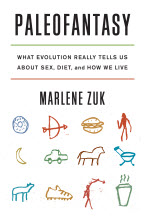 |
| Paleofantasy |
As
a young child, nearly 70 years ago, I purchased a beautifully
illustrated book “The Story of Living Things” and
have been hooked on science and evolution ever since. So when I Saw
Marlene Zuk's book “Paleofantasy - What Evolution really
tells us about sex, diet and how we live” I has hooked by
the subtitle – but puzzled by the short title. On reading the book
I realise I have missed out in life (particularly as it lived in the
United States) as I never read glossy lifestyle
magazines and was virtually unaware of the pseudo-science of caveman diets and
paleo-living surrounding the “back to the glorious past” brigade
which the book aims to address.
Having
got over the shock I found the book a very readable account of the
changes that the coming of agriculture and communal living have had
in evolutionary terms – including how the changes caused by the
selective breeding of our food species have converted what might be
considered unappetising wild species of fruit into their delicious
modern counterparts on the supermarket shelves. I was also very happy with the way it looked at the relationship between milk
products, human evolution and the digestion of lactose. On the
subject of exercise it discusses the fact that humans are naturally
good long-distance runners compared with many other animals and I
found the discussion of persistence hunting (where food animals are
chased till they become exhausted) extremely interesting. I can definitely recommend it for anyone with a genuine scientific interest in how we came to be what we are now.
In
the context of my own studies into the evolution of human
intelligence there was little specifically relating to evolutionary changes in the
inbuilt mechanisms of the human brain (as opposed to cultural changes) but this was compensated by very useful reviews on the
the relationship between men and women and the problems of rearing
children which need many years of support before they reach breeding
age. There are also useful comparisons with evolutionary differences
between races, such as the way Tibetans have evolved to cope with
living at high altitudes. In fact I have flagged these sections for a
detailed re-read following up the many notes and entries in the
comprehensive bibliography.
Overall
I am very pleased to have a copy of this book on my shelf, and only
have one problem with it. When I regularly wrote book reviews for the
New Scientist, one of the key questions I always asked was “what is
the audience this book is written for?” The language is very
readable, with virtually no technical jargon, and so is accessible to
anyone with a smattering of scientific understanding. I can see
a number of the chapters being very useful fodder for a variety of
undergraduate studies as the story they yell really makes you think.
However I was completely put off for the opening words of the introduction which reads “The first thing you have to do to study 4,000 year old DNA is to take off your clothes.” This is exactly the kind of introductory lead I might have expected in a short article in a glossy colour supplement of the type which promotes “natural” eating and “back to the past” life styles. As a serious scientist this sent out all the wrong vibes for me – and looks as if it was only there because an editor told the female author to “say something sexy.” simply to boost sales. This would not matter if the book was aimed at the kind of reader that eats raw meat as result of reading hyped up newspaper articles about the "paradise" of natural living enjoyed by cavemen. Of course I may not be a good judge of how such people think – but I don't think the book, which raises a lot of serious points, and which has virtually no pictures, would appeal to such an audience.
However I was completely put off for the opening words of the introduction which reads “The first thing you have to do to study 4,000 year old DNA is to take off your clothes.” This is exactly the kind of introductory lead I might have expected in a short article in a glossy colour supplement of the type which promotes “natural” eating and “back to the past” life styles. As a serious scientist this sent out all the wrong vibes for me – and looks as if it was only there because an editor told the female author to “say something sexy.” simply to boost sales. This would not matter if the book was aimed at the kind of reader that eats raw meat as result of reading hyped up newspaper articles about the "paradise" of natural living enjoyed by cavemen. Of course I may not be a good judge of how such people think – but I don't think the book, which raises a lot of serious points, and which has virtually no pictures, would appeal to such an audience.

No comments:
Post a Comment